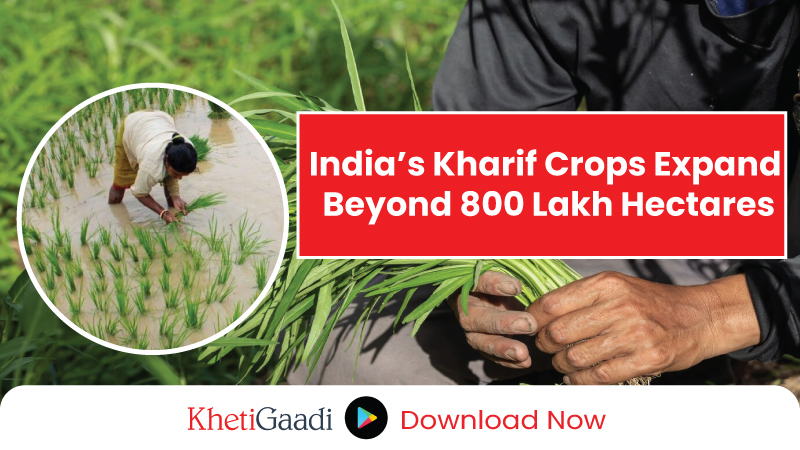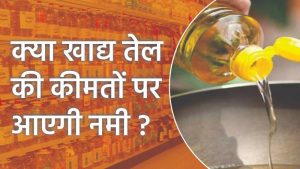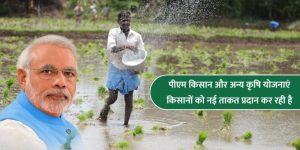Mixed Outcomes and Notable Shifts Mark July’s End in Kharif Crop Coverage
The Ministry of Agriculture and Farmers Welfare has released its latest report on the progress of Kharif crop sowing at the end of July 2024. The data presents a mixed picture of gains and losses in the area coverage of major Kharif crops compared to the same period last year. Overall, the total Kharif crop coverage has reached 811.87 lakh hectares.
KhetiGaadi always provides right tractor information
Stable and Increasing Coverage
- Paddy (Rice): The area under paddy cultivation remains largely stable at 215.97 lakh hectares in 2024, showing a slight decrease from 216.39 lakh hectares in 2023, a reduction of just 0.42 lakh hectares.
- Pulses: This category has witnessed a significant rise in area coverage, jumping from 89.41 lakh hectares in 2023 to 102.03 lakh hectares in 2024, marking an impressive increase of 12.62 lakh hectares. Key contributors to this growth are Arhar (Tur) with an increase of 9.80 lakh hectares and Moongbean, which added 3.36 lakh hectares.
- Shree Anna and Coarse Cereals: These crops have also experienced a boost, with coverage expanding from 145.76 lakh hectares in 2023 to 153.10 lakh hectares in 2024, an increase of 7.34 lakh hectares. Notably, maize has seen a substantial increase of 9.44 lakh hectares.
- Oilseeds: Area coverage for oilseeds has grown from 165.37 lakh hectares in 2023 to 171.67 lakh hectares in 2024, an increase of 6.30 lakh hectares. Groundnut and soybean have been major contributors, with increases of 4.95 lakh hectares and 4.73 lakh hectares, respectively.
Declining Coverage
- Cotton: There has been a notable decrease in cotton cultivation, with the area shrinking by 7.81 lakh hectares, from 113.54 lakh hectares in 2023 to 105.73 lakh hectares in 2024.
- Bajra (Pearl Millet): The area under bajra has also reduced by 4.13 lakh hectares.
- Sugarcane, Jute, and Mesta: These crops have seen only marginal changes. Sugarcane increased slightly by 0.63 lakh hectares, while Jute and Mesta decreased by 0.42 lakh hectares.
If you wish to know organic methods to increase your overall cultivation yield, please call KhetiGaadi counsellor on 07875114466 or write an email to connect@khetigaadi.com
Broader Context and Implications
The overall dynamics in Kharif crop sowing are influenced by various factors, including monsoon patterns, government policies, and market demands. The increase in pulse and oilseed coverage aligns with government initiatives to promote crop diversification and reduce import dependency. However, the decline in cotton and bajra may reflect changes in farmer preferences due to price fluctuations and climate resilience challenges.
India’s agricultural sector remains highly dependent on the monsoon, which affects sowing decisions and crop yield. The erratic nature of rainfall in recent years has prompted farmers to diversify their crop portfolios to mitigate risks. The shift towards pulses and oilseeds is also driven by higher market prices and government support in the form of minimum support prices (MSP).
Looking ahead, continuous monitoring of these trends is crucial for ensuring food security and the stability of the agricultural economy. The government’s focus on promoting sustainable and climate-resilient farming practices will be key to navigating these challenges. As the Kharif season progresses, stakeholders will closely watch how these trends unfold, impacting both farmers’ livelihoods and the broader agricultural landscape.
Stay tuned with us on our whatsapp channel for more real time updates on various agriculture related schemes and innovative cultivation methods aimed at supporting our hardworking farmers.
For more detailed information, visit https://khetigaadi.com/ regularly!
To know more about tractor price contact to our executive






